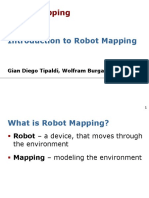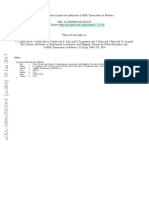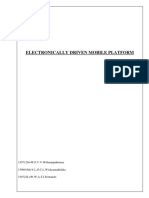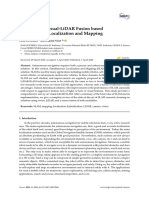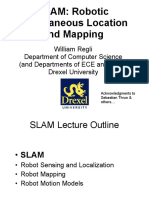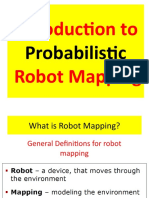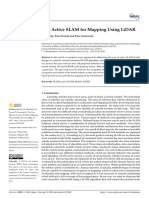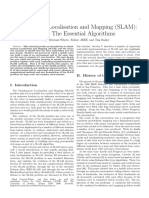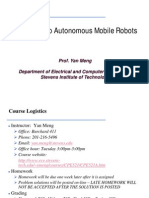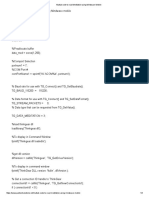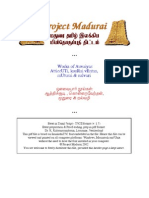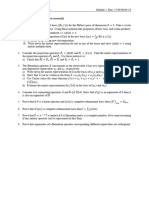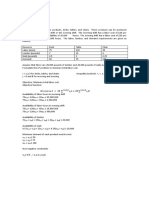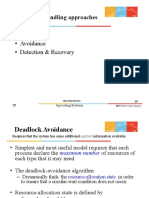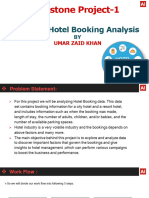NAVIGATION OF A ROBOT IN REAL
TIME ENVIRONMENT CONTROLLED
FROM A VIRTUAL MODEL
THROUGH SLAM TECHNIQUE
�ABSTRACT
Navigation of mobile robots in an unknown environment is always a challenging task. The
challenges involved are robot localization, obstacle mapping, and path planning. Efficient
navigation strategies and techniques are required, to avoid problems of general navigation
methods, such as getting-lost situations and confusing view configurations. In this paper
a recognition-driven navigation system for large-scale 3D virtual environments is
proposed. The proposed system contains three parts, virtual environment construction,
feature database building and recognition-based navigation. The virtual environment is
recorded and reconstructed automatically with depth camera placed over a robot. The
feature database is composed of image patches with features and registered location and
orientation information. The database images are taken at different distances from the
scenes with various viewing angles, and these images are then used to construct a virtual
3D environment. When a robot navigates in the real world, the sensors on board are used
to estimate its location and orientation. These location and orientation information are also
reflected in the 3D virtual environment. Here for localization and mapping of mobile robot
from the real world to the virtual environment the help of SLAM and Markov process in
sought. Advanced filtering algorithms are implemented so as to enhance the navigation.
�AIM
To import a cad model of a building
and to perform a real time mobile
robot navigation through the virtual
model.
�Challenges
Mobile Robots How to move and achieve motion
target goals in (indoor) environments
Localization (where am I?)
Hence
Mapping, simultaneous localization and
mapping SLAM (what is my workspace?)
Path planning (how to get there?)
Obstacle avoidance ( get there safely)
� The act of finding one's location against a map is known
as localization.
So how can a robot localize itself?
The most common form of intelligent localization and
navigation is to use a map, combined with sensor
readings and some form of closed-loop motion feedback.
But a robot needs to do so much more than just localizing
itself. Often, we'd like our robots to be able to build their
own maps, since map building by hand is tedious, boring,
and error-prone.
The field of robotics that studies localization and mapping
is typically called SLAM (simultaneous localization and
mapping).
�NUT SHELL
SLAM is a technique used to build up
a map within an unknown
environment or a known environment
while at the same time keeping track
of the current location.
�To a human
Assume you are blindfolded in a
room
�What is SLAM?
The problem has 2 stages
1. Mapping
2. Localization
The paradox:
1. In order to build a map, we must know our position
2. To determine our position, we need a map!
SLAM is like the chicken-egg problem
Solution is to alternate between the two steps.
� Mapping and Localization are almost
always a precursor to navigation. We
can now break down the several
types of problems that exist in SLAM
Known map, known localization
Known map, unknown localization
Unknown map, unknown localization
�Goals
1.
Robust techniques for
a.
b.
c.
2.
3D environment modeling
Localization
Navigation and action planning
Challenges arise from
a.
b.
c.
d.
Inherently noisy sensor data
Inaccurate motion execution
Huge state space
Dynamics
�Open Problems
Classification of regions according to
navigation complexity
Efficient updating of 3D map
structures
Representing (movable) objects in
space
Representing typical configurations
of objects in 3D (e.g., doors, drawers)
�Autonomous Navigation- Research Directions
Given
An environment
representation - Map
Knowledge of current
position C
Target position G
A path has to be planned
and tracked that will take
the robot from C to G
�Autonomous Navigation- Research Directions
During execution (runtime)
Objects / Obstacles O
may block the robot
The planned path is nolonger valid
The obstacle needs to be
avoided and the path
may need to be replanned
C
O
G
X
�Navigation Issues
Important questions
Where
Where am
am II
Important navigation issues
Robot
Robot localization
localization
Where
Where are
are other
other places
places
relative
relative to
to me
me
Map
Map building
building
How
How do
do II get
get to
to other
other
places
places from
from here
here
Path/motion
Path/motion
planning
planning

